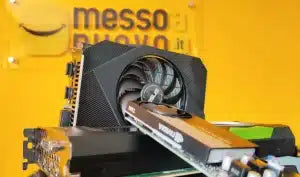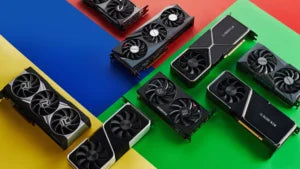GPU Editing vs GPU Gaming, what is the difference between these two families of video cards? KEY: GPU Editing vs GPU Gaming
The main purpose of a video card is to transform a digital signal into an image to be displayed on a monitor.

To carry out this important function, the video card is equipped with a processor and a certain amount of memory dedicated to graphics display.
Video cards
There are video cards of all types, made according to specific needs and requirements. They range from the basic ones (in which even the video functionality can be incorporated into the motherboard) to the advanced and dedicated ones.
We can find two possible different uses of this second category.
Very different uses requiring very different strengths and characteristics. This is why all video card manufacturers (primarily Nvidia and AMD) have gradually differentiated their offer of cards, also thinking of them according to specific use.
The two most famous families are, for example, Nvidia Quadro and GeForce, with the first dedicated to "work" editing uses and the second to "fun" gaming uses.
GPU Editing vs GPU Gaming, the difference.
The GPU (Graphic Processing Unit, abbreviation and name in English of the video card) can therefore be an editing GPU (or professional GPU) or a gaming GPU .
To better understand the differences, let's study the various families of video cards made by Nvidia.
Nvidia currently divides its cards into three different families, with one of them little known, given that it is designed almost exclusively for computer laboratory computing uses.
Let's find out:
 GPU Editing vs GPU Gaming, prices
GPU Editing vs GPU Gaming, prices
The series of video cards designed for editing have a significantly higher cost with the same performance and features than cards designed for gaming .
We can consider a cost of up to four or five times higher.
What are the other differences?
There are some parameters in which the two families of video cards differ. In particular, in these aspects:
GPU Editing vs GPU Gaming, the common points
Many differences but also a fundamental point in common, that of the type of architecture from which both cards derive. Both GPU Editing and GPU Gaming are based on the same architecture, known as Nvidia Turing.
This architecture, launched in 2018, revolutionized the video card market, offering for the first time, on all cards derived from Turing, some very important features, such as:
Another point in common is that of the chip used.
The TU102 chip for example, one of the most famous of this series, is used both for the GeForce RTX series (2080 Ti) and for the Quadro series (RTX6000 and RTX8000).
Its larger version, the TU104 chip is also shared between the two series. In fact, we find it on the GeForce RTX series (2060, 2070, 2080 and 2080 super), and on the Quadro series (RTX5000).
This “duality” then continues for other chips.
But why do different cards arise from a single chip, and what are the differences?
The reason therefore crosses over from "technical" to marketing, with differences between the two configurations that are "fixed on the drawing board" in order to maintain a difference between the two series.
What is therefore varied is the number of Cores, the operating frequency, the amount of memory and the bus width.

GPU editing and GPU gaming, find the differences
These construction characteristics therefore lead to the creation of video cards that tend to resemble each other, if not even to be the same.
For example, the Quadro RTX4000 has very similar, if not identical, features to the GeForce RTX2070.
The same type of comparison, with the exception of the amount of RAM, can also be seen between Quadro RTX5000 and Geforce RTX 2080 Super.
The same thing happens between the Quadro RTX 6000 and the GeForce RTX 8000, which are similar at the chip level but differ in the amount of memory.

Differences
If technically and from the point of view of the main functions the Gaming CPUs and the Editing CPUs are similar, how do they differ?
Essentially in the use of drivers.
GeForce drivers are created and updated with the fact that this card is intended for gaming in mind. So this card optimizes performance, fixes bugs and improves stability and compatibility of the various games produced and released.
The Quadro drivers are instead created with the same expertise and the same type of approach, but designed for business and professional uses.
This card therefore presents complete "interaction" and compatibility with graphics editing applications that require a very high-performance and high-intensity GPU .
The target of this use is in fact 3D design, graphic editing, video processing and the production of professional content.
Compatibility
If for the GeForce series we can count on good compatibility with regards to professional software, for the Quadro series this compatibility is guaranteed. This "certification" means that the company that developed the software kept the potential of the Quadro GPUs in mind, making the most of them.
GPU Editing vs GPU Gaming, conclusions 
Built on the same architecture and based on the same chip family, Quadro and GeForce cards differ almost exclusively in terms of memory and frequency.
Therefore we will have to consider the greater outlay necessary for a panel board only when the applications and the planned work require it, in all other cases the risk is spending more for nothing.











